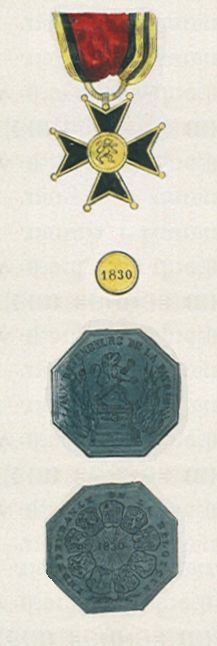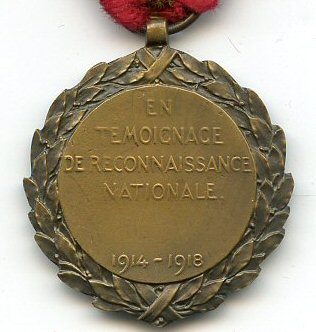
The King Albert Medal was a Belgian medal established by royal decree on 7 April 1919 and awarded to both Belgians and foreigners who were exceptionally meritorious in promoting, organising or administering humanitarian and charitable work that assisted Belgians in need during the First World War.
The Military Cross is a military long service decoration of Belgium. It was established by Royal Decree on 11 February 1885 and is awarded to commissioned officers in the Belgian Armed Forces for loyal and uninterrupted service or to Non-Belgian military officers for distinguished service in favor of the Military of Belgium.

The Volunteer Combatant's Medal 1914–1918 was a Belgian wartime service medal established by royal decree on 17 June 1930 and awarded to Belgian citizens and foreign nationals who voluntarily enlisted for service in the Belgian Armed Forces during World War I.

The 1914 – 1918 Fire Cross was a Belgian military decoration awarded to all holders of the so-called "Fire Card" which was awarded to all who came under fire at the front during the First World War. The medal was established by royal decree on 6 February 1934. It could not be awarded posthumously.
The Civic Decoration is a civilian decoration of the Kingdom of Belgium. It was first established by royal decree on 21 July 1867 to reward exceptional acts of bravery, devotion or humanity. A further royal decree of 15 January 1885 extended the award to state civil servants for long service by a mere change of ribbon. The award statute was once again amended by royal decree in 1902 to include long service in the Civic Guard and firefighters, each with its distinctive ribbon.
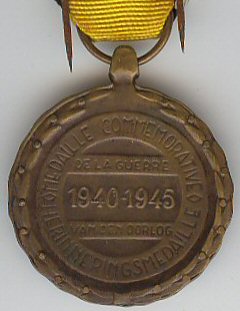
The Commemorative Medal of the 1940–45 War was a military decoration of Belgium. It was established by royal decree of the Prince Regent on 16 February 1945 to recognise Belgian servicemen and women who served during World War II. It was also awarded to members of the Belgian Resistance and members of Belgium's Merchant Navy on the side of the Allies. Later decrees allowed for its award to foreign recipients of the Belgian Croix de Guerre.

The Yser Medal was a Belgian campaign medal of World War I, established on 18 October 1918 to denote distinguished service during the 1914 Battle of the Yser in which the Belgian Army stopped the German advance of the German invasion of Belgium.

The 1940–1945 Military Combatant's Medal was a Belgian war medal established by royal decree on 19 December 1967 and awarded to all members of the Belgian Armed Forces who fought from the United Kingdom during the Second World War.

The Volunteer's Medal 1940–1945 was a Belgian war medal established by royal decree of the Regent on 16 February 1945 and awarded to Belgian and foreign civilians who voluntarily enlisted in the Belgian Armed Forces during the Second World War. The medal could also be awarded to volunteers serving in the Belgian units of the Royal Air Force, Royal Navy or British merchant navy.
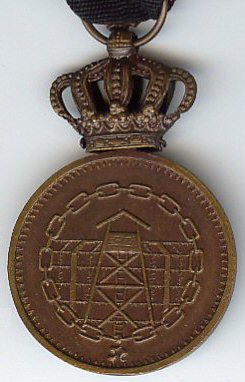
The Prisoner of War Medal 1940–1945 was a Belgian war service medal established by royal decree on 20 October 1947 and awarded to all members of the Belgian Armed Forces imprisoned by Axis Forces during the Second World War.
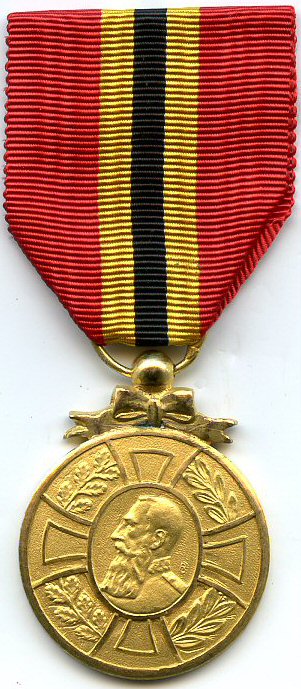
The Commemorative Medal of the Reign of King Leopold II was a Belgian civilian and later military and police forces medal originally established on 21 July 1905 by royal decree to commemorate the 40th year of the reign of King Leopold II.
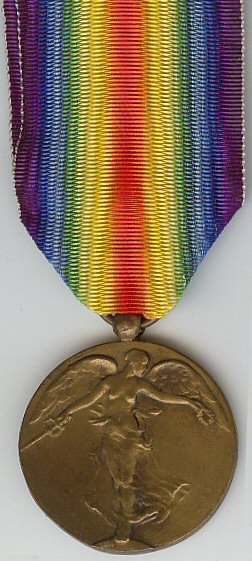
The Victory Medal is the Belgian variant of the Inter-Allied Victory Medal 1914–1918 was a Belgian commemorative war medal established by royal decree on 15 July 1919 and awarded to all members of the Belgian Armed Forces who served during the First World War. Later royal decrees enlarged the list of potential recipients to include service in African campaigns and under special circumstances, to members of the merchant navy and fishing fleet. In all, 350,000 were awarded.

The Maritime Medal 1940–1945 was a Belgian bravery award of World War II, established by Royal Decree on 17 July 1941 and awarded to members of the Belgian Navy, merchant navy or fishing fleet for acts of heroism in the saving of ships or lives during an action against the enemy.

The Political Prisoner's Cross 1940–1945 was a Belgian war medal established by royal decree of the Regent on 13 November 1947 and awarded to Belgian citizens arrested and interned by the Germans as political prisoners during the Second World War. The award's statute included provisions for posthumous award should the intended recipient not survive detention, and the right of the widow, the mother or the father of the deceased to wear the cross.

The Centenary of National Independence Commemorative Medal 1830-1930 was a Belgian commemorative medal established by royal decree on 20 July 1930 to commemorate the 100th anniversary of Belgian independence.
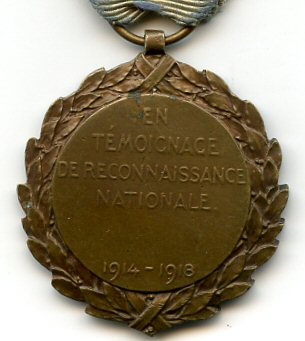
The Political Prisoner's Medal 1914–1918 was a Belgian medal established by royal decree on 26 December 1930 and awarded to Belgian civilians who were detained for a minimum of one month by the Germans during the First World War following an act of courage or devotion towards the Allies' cause.

In 1833, following the end of the Belgian Revolution, the young kingdom of Belgium created the Iron Cross to recognise wounds received and bravery in battle. The award first class was bestowed to the wounded who elected to stay at their post and keep fighting, to the maimed and mutilated, as well as for acts of courage, the award second class was bestowed to all wounded combatants. In 1835, due to the discontent of most recipients, the award 2nd class was terminated and all received the first class. Over the years, recipients of the Iron Cross received ever increasing pensions, up to ten years of seniority when employed as civil servants and pensions for the widows and orphans of the deceased. The other combatants of 1830-1831 received no pension, and no commemorative medal was struck.

The Commemorative Decoration of the 50th Anniversary of the Creation of the Railroads 1834-1884 was a Belgian commemorative award denoting the 50th anniversary of the law of 1 May 1834 ordering the creation of railroads in Belgium. It was established by royal decree of King Leopold II on 30 April 1884 at the suggestion of the ministers of Public Works and of the Interior, its statute was ratified by a further royal decree on 11 July 1884.

The Queen Elisabeth Medal was a Belgian decoration created by royal decree in October 1916 to recognise exceptional services to Belgium in the relief of the suffering of its citizens during the First World War. Its statute was ratified on 14 May 1919. It was awarded to people, both Belgians and foreign nationals, who, like Queen Elisabeth herself, had worked and cared for the suffering victims of war for a year or more prior to 10 September 1919. Although not limited to medical care of the sick and wounded, recipients who earned the medal by working in hospitals received a variant with a red enamelled cross within the suspension wreath. A great many Belgian and foreign doctors and nurses received the medal.
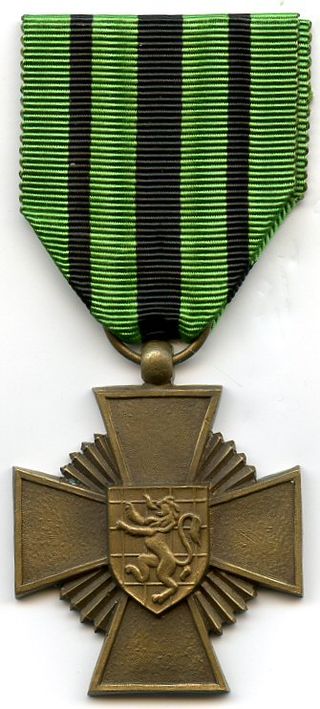
The Escapees' Cross 1940–1945 was a Belgian war service medal established on 25 February 1944 by the Belgian government in exile in London. It was awarded to all Belgian citizens who, during World War II, escaped from occupied Belgium, from another occupied land or from Germany and that, following said escape, had proven their patriotism by joining and serving with a resistance group, or had been imprisoned for a minimum of three months following an act of patriotism, or for having travelled clandestinely to participate in a Belgian action aimed at promoting the war against the enemy. Escaped prisoners of war could also be awarded the medal if they met this last criteria.



